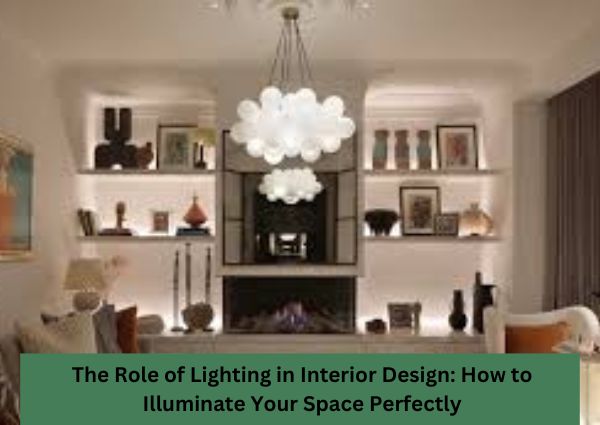Lighting plays a critical role in interior design, transforming a space from ordinary to extraordinary. Whether you’re working on a residential project or a commercial space, the right lighting can enhance the ambiance, highlight architectural features, and even impact the mood and functionality of a room. As a construction and interior design company based in Gurgaon, we understand the significance of lighting in creating visually stunning and functional spaces. In this blog, we’ll explore how to illuminate your space perfectly, offering tips and insights on different types of lighting and their applications.
Understanding the Basics: The Three Types of Lighting
- Ambient Lighting
Ambient lighting, also known as general lighting, provides the primary illumination in a room. It is designed to create a comfortable level of brightness without glare, enabling you to see and move around safely. Think of ambient lighting as the foundation upon which other lighting layers are built.
Examples of ambient lighting include:
– Ceiling-mounted or recessed fixtures
– Chandeliers
– Track lighting
– Wall-mounted fixtures
Tip: When designing ambient lighting, consider the size and function of the room. A large living room may require a central chandelier paired with recessed lighting, while a bedroom might benefit from a softer, more diffused light source.
- Task Lighting
Task lighting is focused lighting that helps you perform specific tasks such as reading, cooking, or working. Unlike ambient lighting, task lighting is localized and often more intense to reduce eye strain and improve efficiency.
Examples of task lighting include:
– Desk lamps
– Under-cabinet lighting in kitchens
– Pendant lights over a kitchen island
– Reading lamps by a bed or sofa
Tip: Ensure task lighting is adjustable so that the intensity and angle can be modified based on the task at hand. Dimmable fixtures are a great choice for versatile spaces.
- Accent Lighting
Accent lighting adds drama and style by highlighting specific objects or architectural features, such as artwork, sculptures, or textured walls. This type of lighting draws attention to elements you want to emphasize, creating focal points within a room.
Examples of accent lighting include:
– Wall-mounted picture lights
– Spotlights
– LED strips under shelves
– Recessed lights aimed at a feature wall
Tip: Use accent lighting sparingly to avoid overwhelming the space. The goal is to complement, not overshadow, the other design elements in the room.
Layering Light: The Key to a Balanced Design
A well-designed lighting plan incorporates all three types of lighting—ambient, task, and accent—creating layers that add depth and dimension to a space. This approach allows you to control the mood and functionality of a room, ensuring that the lighting adapts to various needs throughout the day.
For example
– In a living room, ambient lighting from a central chandelier could be complemented with task lighting from floor lamps near reading areas, while accent lighting might highlight a piece of art on the wall.
– In a kitchen, ambient lighting from recessed ceiling lights can be enhanced with task lighting under cabinets and pendant lights over the island, with accent lighting highlighting a backsplash.
Choosing the Right Fixtures and Bulbs
Selecting the right fixtures and bulbs is crucial to achieving the desired lighting effect. The style of the fixture should align with your overall design aesthetic, whether it’s modern, traditional, or eclectic.
Fixture Tips
Chandeliers: add elegance and are perfect for dining rooms, foyers, or living rooms.
Pendant lights: offer versatility and are ideal for kitchen islands or dining tables.
Wall sconces: provide subtle illumination and work well in hallways or as bedside lights.
Bulb Tips
LED bulbs: are energy-efficient and come in a variety of color temperatures, from warm to cool.
Incandescent bulbs: emit a warm light but are less energy-efficient.
Fluorescent bulbs: are energy-saving but may not be suitable for spaces where ambiance is key.
Color Temperature
Consider the color temperature of the bulbs, measured in Kelvins (K). Lower Kelvin values (2700K-3000K) emit a warm, cozy light, ideal for living rooms and bedrooms. Higher Kelvin values (4000K-5000K) produce a cool, white light that is suitable for workspaces and kitchens.
Lighting and Mood: How Light Affects Emotions
Lighting not only affects the visual appeal of a space but also impacts our emotions and well-being. Warm lighting creates a cozy and inviting atmosphere, making it perfect for areas where relaxation is key, such as living rooms and bedrooms. Cooler lighting, on the other hand, is more energizing and is often used in offices or kitchens where focus and productivity are important.
Mood Tips
– Use dimmable lights to adjust the intensity and create different moods for different occasions.
– Incorporate natural light wherever possible, as it enhances well-being and reduces the need for artificial lighting during the day.
Conclusion: Illuminate Your Space with Purpose
Lighting is an essential element of interior design that should not be overlooked. By understanding the different types of lighting and how to layer them effectively, you can transform any space into a beautifully illuminated environment that is both functional and aesthetically pleasing. Whether you’re designing a cozy living room, a productive office, or a luxurious bedroom, the right lighting can make all the difference.
At 3s Buildcon, we specialize in creating custom lighting solutions that enhance the beauty and functionality of your space. Contact us today to learn how we can help you illuminate your home or office perfectly.

